Scotland's Loch Ness Monster
Nessie the Loch Ness Monster is probably the most well-known of Scotland's loch creatures (and yes, once you've finished here you can check out this page to learn more!).
While Loch Ness and it’s surroundings are wild, and hauntingly beautiful, it’s natural charms are not the source of it’s worldwide fame. For that it has its resident monster, Nessie, to thank!
There are literally thousands of documented sightings of a strange creature in Loch Ness, so many that it’s impossible to keep an accurate count as it's constantly changing.
The very first encounter with the monster of this loch was in the sixth century. But in spite of that, today Nessie remains as much of a mystery, and an enigma, as ever.
- About Loch Ness
- Loch Ness Monster History
- Early loch creature sightings
- Loch Ness monster sightings from 1833 onwards
- Dedicated Nessie followers
- Loch monsters on land
- Loch Ness monster hoaxes
- Nessie FAQ
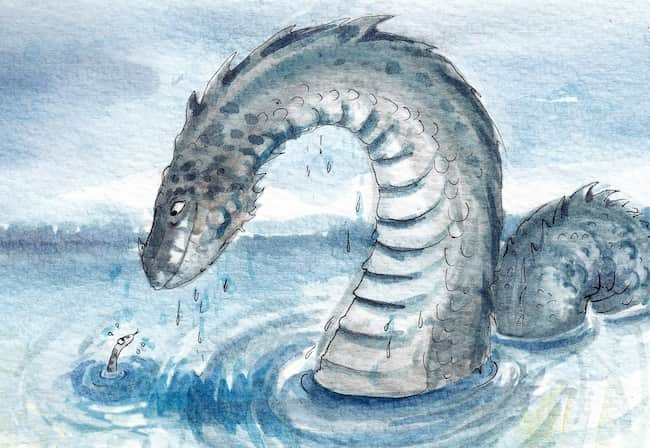
About Loch Ness
Although not the largest Scottish loch in terms of surface area, Loch Ness is the largest in terms of volume of water.
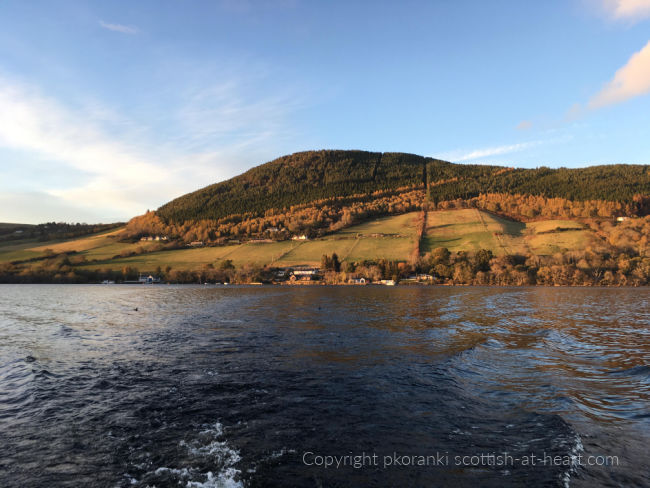 The banks of Loch Ness seen from the water. Copyrighted photo.
The banks of Loch Ness seen from the water. Copyrighted photo.At approximately 23 miles long and an average width of about one mile, it’s a very long and uniformly slender loch. With a maximum depth of 745ft it also extremely deep. Because the loch is so narrow, and so deep, there isn’t much shallow water in Loch Ness, and it drops off precipitously from the shoreline.
The city of Inverness sits only a few miles from the northern tip of Loch Ness where the River Firth flows from the loch to empty into the Moray Firth.
On the western shore of the loch, about five miles south of the norther tip, sit the ruins of the 16th century Urquhart Castle. It’s a great spot to visit and look out over the loch, which I'm sure looks remarkably unchanged since the castle was built.
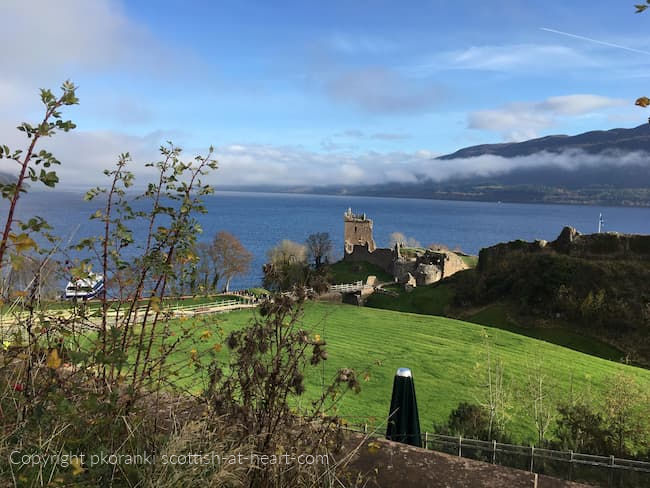 Urquhart Castle. Taken by one of my daughters. Copyrighted photo.
Urquhart Castle. Taken by one of my daughters. Copyrighted photo.A boat trip out onto the lake is a good way to get a feel for the depth and mystery of this famous loch and there are many options to choose from from one end of the loch to the other.
A few miles from Urquhart Castle is the village of Drumnadrochit where you can find the Loch Ness Center and Exhibition. Inside you can take a close look at the history of Nessie as well as artifacts such as submarines used to search for her. With multi media displays, gifts and more it's also well worth a visit!
Today, Loch Ness is much less remote than many other Scottish highland lochs. The existence of a castle on the loch, and the draw of the monster make it a popular tourist destination.
The relatively busy A82 road, which hugs the entire length of the Loch Ness’s western shore (completed in 1933), plays an important role in the numerous sightings as it’s very easy to get good, relatively unobstructed, views.
As Loch Ness is interconnected to several rivers and other lochs it would be relatively easy for a creature living in one loch to travel between, and through, these bodies of water fairly regularly.
Loch Ness might be part of a ‘loch monster highway’ for all we know!
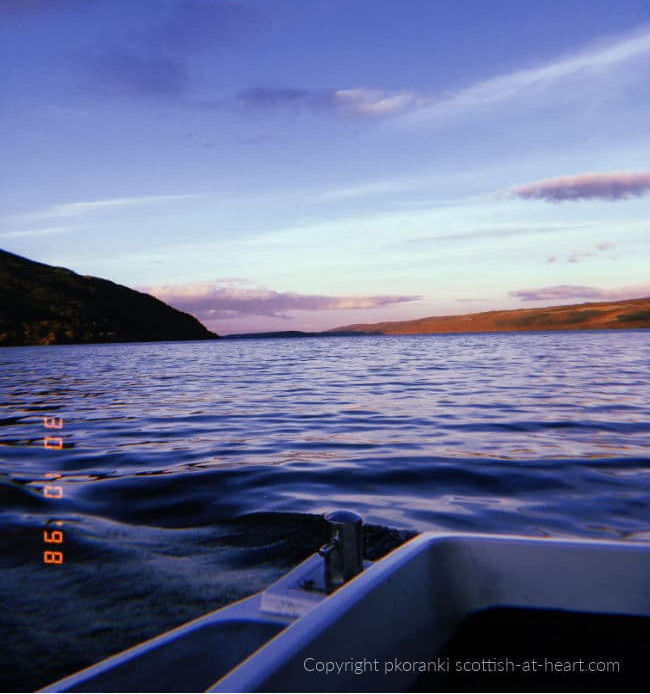 Photo of Loch Ness at dusk, taken by one of my daughters. Copyrighted photo.
Photo of Loch Ness at dusk, taken by one of my daughters. Copyrighted photo.Nessie sightings continue in 2022
On April 4th, 2022 something large (estimated to be about 30 feet long) was captured moving on sonar at a depth of just over 400 feet in Loch Ness. Tourist Tom Ingram, from Portsmouth, saw the image when the tourist cruise he was taking was close to Invermoriston.
On Good Friday 2022, Glen Blevins, from Inverness, may have gone one better as he spotted TWO large objects moving about in the water near Aldourie Castle.
Source: Daily Record Newspaper UK
Loch Ness Monster History
Although the legend of Nessie really started to get its legs (so to speak) in the 1930’s, after which there are thousands of eyewitness reports of sightings, there are numerous references to sightings of the creature being made hundreds of years earlier.
The first documented sighting of the Loch Ness Monster was in the 6th century AD, and it’s likely that local inhabitants (and invaders/colonizers) were already aware that strange creatures existed in the loch by this point.
Why? Because the Picts, an ancient group who were living in Scotland at that time and whose ancestors had been in the north of Scotland since the first century AD, left many artifacts and traces of their presence, including carvings.
A very popular subject (up to 40% of all animals carved by the Picts) shown in these carvings was a strange creature which looked something like an aquatic elephant, a dragon or even a sea horse. It appears to have a long snout, flippers, a tail and a tail-like-appendage sprouting from the top of its head.
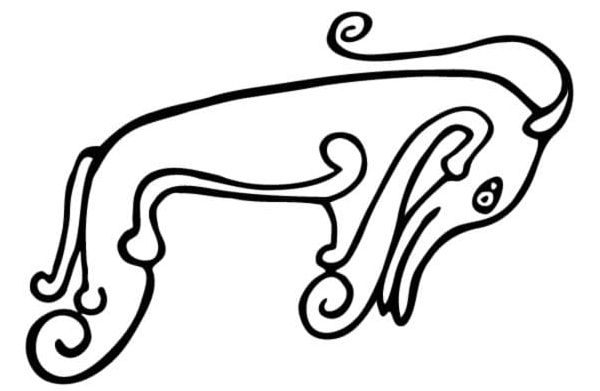 By Struthious Bandersnatch - Own work, CC BY-SA 1.0, https://commons.wikimedia.org/w/index.php?curid=9129402
By Struthious Bandersnatch - Own work, CC BY-SA 1.0, https://commons.wikimedia.org/w/index.php?curid=9129402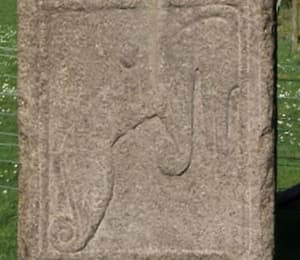 By Maiden_Stone.jpg: Otterderivative work: Kallewirsch (talk) - This file was derived from: Maiden Stone.jpg:, CC BY-SA 3.0, https://commons.wikimedia.org/w/index.php?curid=18433133
By Maiden_Stone.jpg: Otterderivative work: Kallewirsch (talk) - This file was derived from: Maiden Stone.jpg:, CC BY-SA 3.0, https://commons.wikimedia.org/w/index.php?curid=18433133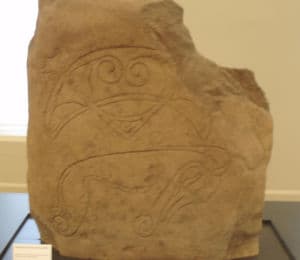 Strathmartine Castle Stone
Strathmartine Castle Stone
By Catfish Jim and the soapdish - Own work, CC BY-SA 3.0, href="https://commons.wikimedia.org/w/index.php?curid=11041873
But now let’s start at the beginning of the recorded Loch Ness creature sightings and jump into the incredible and fascinating world of Nessie!
Loch Ness Monster sightings
Overall, there are thousands of recorded sightings of the Loch Ness monster and the number rises every year.
According to the Loch Ness Monster Sightings Registry there were five reported sightings of Nessie in 2021, but none as yet recorded for 2022 (as of March, 2022).
In addition to those sightings that are documented by eye witnesses, there are probably many, many more that aren’t mentioned or recorded.
Some people may not want to admit to seeing something that science hasn’t been able to prove exists, others may only tell family or close friends.
From what I was able to find out there is no single definitive list of Nessie sightings, and although there are many comprehensive ones online, I’d be willing to bet that not all reported sightings make it onto any list, let alone just one.
Earliest Sightings of a strange creature in Loch Ness
According to Christianity.com it was in the year 565 AD that an Irish monk and priest, named Crimthann (who was later to become St. Columba, which is what I'll call him now) was eye witness to the first documented sighting of the Loch Ness Monster.
St. Columba had been exiled from his native Ireland and chose to live on the Isle of Iona off the west coast of Scotland.
On the occasion we're talking about he was staying on the shore of the Loch Ness, near the mouth of the River Ness, en-route to visit a Pictish King, when he came across some Picts burying a man who had been attacked and killed by a water beast in the river.
Columba placed his staff on the man’s chest and brought him back to life. He then told one of his monks swim across the river to get a boat for him to cross in, which seems less than saintly perhaps, given what had just happened! As the obliging monk swam across, the monster rose out of the water and chased him.
Seeing that, Columba made the sign of the cross as he invoked the name of the Lord, and shouted ‘You will go no further! Do not touch the man! Leave at once!’ Apparently the monster obeyed without question, stunning the Picts who (allegedly) converted to Christianity on the spot.
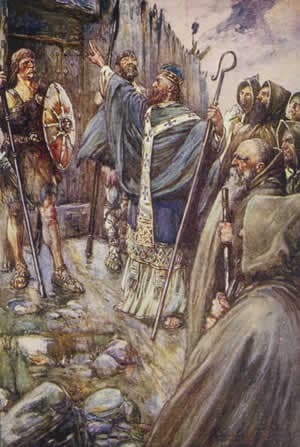
Being that this incident was only put into writing over one hundred years later when St. Adamnan was putting together a written record of Columba’s miracles, chances are there was some artistic license taken with this story.
As with most legends there is probably a kernel of truth in the story, and Columba likely learned of the monsters existence from the Picts of the area , so although the sighting was in the River Ness as opposed to the loch itself, it puts the existence of Nessie as early as the 6th century firmly on the historical map.
Although the first documented sighting of the Loch Ness Monster was in the 6th century AD, it’s likely that local inhabitants (and invaders/colonizers) were aware of the possibility that strange creatures existed in that area.
Why? Because the Picts, an ancient group who were living in Scotland several hundred years earlier, had left many artifacts and traces of their presence, including carvings.
A very popular subject (up to 40% of all animals carved by the Picts) shown in these carvings was a strange creature which looked something like an aquatic elephant, a dragon or even a sea horse.
It appears to have a long snout, flippers, a tail and a tail-like-appendage sprouting from the top of its head. Or perhaps they’re really long ears.
There are a handful of reported sightings of the Loch Ness monster in the late 1800’s and very early 1900’s, and given the names of the eyewitnesses these were likely all locals, at the very least all Scots!
Although Loch Ness wasn't as busy an area as it became after the upgrade to the A82 in 1933, it was still far from being as isolated as many of Scotland's lochs. The proximity if Inverness, and the Caledonian Canal (completed in 1847) made this a comparatively well populated loch.
Very few details are given but there are several recurring themes in the descriptions which are also seen in sightings up to this present day. Interestingly the eyewitnesses don’t seem to describe just one creature, or if they are describing the same creature, they’re seeing different parts of it, in different positions, which significantly change the way it presents itself.
The only ‘wild card’ is the horse-like head with a mane which has occasionally (but consistently) been reported over the years. In the earlier sightings, the folklore of Kelpies and Water Horses may have influenced this, but personally I doubt that would have been true much past the mid 1900’s.
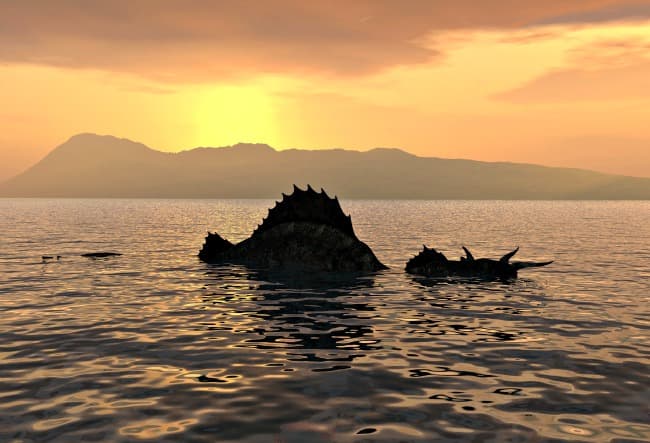 Artist's imaginative image of how the Loch Ness Monster could appear
Artist's imaginative image of how the Loch Ness Monster could appearAlthough in 1885, Roderick Matheson described what he saw as ‘biggest thing I ever saw, neck like a horse with a mane’ and in 1888 Alexander Macdonald called it ‘salamander like’, most early eyewitness descriptions I found likened the part of the creature they could see to the hull of an upturned boat….
- ‘An upturned boat’ 1885
- ‘Hump like an upturned boat’ 1903
- ’10-12ft like upturned boat’ 1923
- ‘2 or 3 shallow humps undulating along back’ 1930
There was also a lot of similarity in terms of what the creature was doing, and how it moved.
Generally it appeared to be just floating, then just turned away or submerged itself…
- ‘Creature lying in the water, flush with the surface’ 1908
- ‘Stationary, moved off in an arc, submerged’ 1923
- ‘Motionless, sank with a splash’ 1929
- ‘Splash, moved in an arc at 16-17 mph, submerged’ 1930
- ‘Little or no motion, sank’ 1932
Loch Ness Monster sightings from 1933 onwards
After an upgrade to the A82 in 1933 (which runs the length of Loch Ness along the north-west shore, literally within a stone's throw of the water), sightings of a creature in the loch really took off, with at least seventeen documented sightings in that year alone.
1933: Mr and Mrs Mackay from Drumnadrochit saw something a disturbance in the water of the loch about three quarters of a mile out from Abriachan (at the northern end of the loch near the River Ness).
They described the creature as ‘rolling and plunging for fully a minute’ and said its body resembled a whale, with the wake it created suggesting it was at least as big 'as a paddle steamer' * and that it disappeared in a 'boiling mass of foam'.
This eye witness account was reported in the Inverness Courier the following month, and can see a clipping of the original newspaper article here.
* Over two days in 1872, several eye witnesses saw a creature in Loch Hourn (and in open water where the loch opened up into the Sound of Sleat) multiple times.
What’s interesting is that they also described it as being at least as big as a mail steamer.
My research showed those boats were around 70 feet long and weighed about 50 tons. So these are big creatures we're talking about.
Because of the sheer volume of Loch Ness monster sightings after 1933 I can't share them all on this page, but here are three for you to check out:
1934: Alex Campbell, a water bailiff on Loch Ness (loch law enforcement officer) was at the mouth of the River Oich (where it joins Loch Oich to Loch Ness) on a clear, sunny morning hoping to catch some salmon.
Without warning he saw the water surge and a long neck topped by a small head appeared out of the water about 250 yards from where he was standing, followed by a long, curved, humped body. Campbell describes the creature ‘turning and jerking it’s head this way and that’.
He estimated the size of the creature to be about 30 feet long, and slate grey with skin like an elephant. After about three minutes the creature dived back underwater, ‘causing a swell at least twice as strong as the one when it surfaced’.
1961: One evening in the Spring of that year, George Coutts and three companions were driving on the B52 near Foyers on the south-eastern shore of Loch Ness . They were stopped in a lay-by (aka a 'turn out' or 'pull out' in the USA) and when looking back up the shore towards Inverfarigaig they noticed what looked like an upturned boat on the loch about 1/4 mile from the shore. It was motionless, and looked 'like an elephant's back'. It wasn't until 2019 that Coutts told anyone about what they had seen that evening.
1975: Two policemen patrolling the west side of the loch late in the afternoon heard an ‘awful row’ (translates to 'one heck of a noise') coming from the loch.
Thinking that there may be a car in trouble they ran down
to take a look but instead of a car they saw two fins sticking two or three
feet out of the water, and around the fins the water was ‘like a pot of boiling
water’ whereas the rest of the loch was as calm as glass.
1996: Gary Campbell, an Inverness local, was parked off the road near the Loch catching up with some paperwork when he happened to look up and caught sight of a black hump rising from the water.
As he stared it went back underwater, then surfaced again, then went back down for good. He said the creature was black but wasn’t able to estimate its size other than ‘BIG!’.
Nessie Sighting on Apple Apps.
One fairly recent and very exciting Loch Ness Monster sighting comes in the form of fascinating footage of an enormous, and strange, creature in Loch Ness was captured on Apple Maps.
Found on satellite imagery taken by Apple for it's smartphone maps, this, at least for me, is a very exciting image.
Although depending on where you are or what browser you're using you may not be able to watch the video on this page, but if you scroll down a little you'll see the image.
At a distance it’s not easy to see, and yes, you have to use your imagination, but when zoomed in it looks very much like some very large creature beneath the water, and as yet no one has been able to say for sure what it is, or isn’t.
At the end of this page I've cited the articles, websites and resources that I used during my research.
You'll find several websites there that have comprehensive lists of Nessie sightings if you'd like to see details of other close encounters with this famous loch creature!
Nessies' Most Dedicated Fans & Followers
Nessie the Loch Ness Monster has some very dedicated and patient followers.
At least two of whom spent a huge percentage of their lives pursuing her, and trying to prove her existence to the rest of the world....
Steve Feltham
Steve has been searching for the Loch Ness monster since 1991 when, at age 28, he walked away from his normal life to set up home on the shore of the loch to devote 100% of his time to finding Nessie.
Steve holds the Guinness World Record for the longest, continuous monster-hunting vigil of the loch and says he 'hasn't regretted a day of it'.
If anyone could be considered an expert on the Loch Ness creature you’d think it would be Steve, and after so many years you’d also think he may have some answers, but the cold, dark, ancient waters of the loch isn’t ready to give up its secrets just yet.
Watch his story here and visit his website to learn more.
Tim Dinsdale
Tim Dinsdale was a British aeronautical engineer who became a cryptozoologist (someone who studies, and searches for legendary or extinct animals) after a 1959 magazine article ignited his interest in the Loch Ness monster phenomenon and in 1960 he spent six days at the loch.
While there he filmed a moving object on the lake which he was convinced was the loch creature.
His films caused quite a sensation at the time and in 1961 he published a book (unimaginatively) entitled Loch Ness Monster. His filming was evaluated several times over the years, with no clear confirmation that it was a living creature, but also none that it was not.
Tim did see the creature again in 1970 and described a ten foot long neck sticking out of the water, and at a distance of half a mile it was ‘as thick as a telegraph post’, and then again in 1971 when he saw 4 ft. of neck from about 250 yards.
Tim continued to visit the loch as often as he could afford to, but was never able to catch the creature on film again.
In 1987 he was recognized by the International Society of Crytozoology for his ‘many years of tireless efforts and fieldwork concerning the Loch Ness Monster’ and was made an Honorary Member.
You can see his 1960 video for yourself here.
His biography 'The Man Who Filmed Nessie' (written by his son Angus Dinsdale) is a fascinating look at this one-of-a-kind a man who had the courage to follow his passion, and the courage and integrity to never give up, even in the face of stiff odds. The forward by his wife Wendy sets the stage in an amusing and down to earth way and is a great starting point.
Loch Monsters on Land
Although, as expected, most of the sightings of strange loch creatures have taken place IN the lochs, they have occasionally been seen on land, one even having apparently crossed a road near the River Tay late at night!
Loch Ness has had more than it’s fair share of these types of sightings, in the late 1800’s to mid 1900’s, although there is even one as recent as 1960. Here are a couple of them:
1879: a group of children saw a strange creature come down a hillside to the loch and waddle into the water. They described it as being the color of an elephant (so, gray) with a long neck and a small head.
1923: Alfred Cruickshank saw the creature at night, but gave a pretty detailed description. He said it was approx.. 20 - 24ft long overall (with half the length being the body and the other half the tail); khaki green in color; arched back; four legs like those of an elephant with webbed feet.
1933: George Spicer and his wife were in their car when saw a huge creature cross the road in front of their eyes. They described it as 'having a large body, about 25ft long and 4 ft. tall, with a long narrow neck slightly thicker than an elephant's trunk and approx. 10-12 feet long' (they used the width of the road to help them estimate size). They didn't notice any limbs, or tail, but as the creature was moving very quickly and they were staring in amazement that is probably not surprising!
George Spicer said that it was 'the nearest approach to a dragon or pre-historic animal that I have ever seen in my life', and described the creature's neck moving up and down 'in the manner of a scenic railway'. They noted that it had an animal of some kind in it's mouth and that it left a trail of broken undergrowth on the sides of the road.
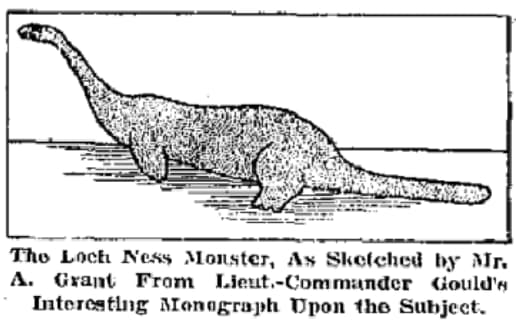
1934: Arthur Grant saw a creature with a small head and long neck, bulky body with 2 slight humps and a long tail. He estimated overall length to be 15-20 ft. It was black or dark brown and had four flippers, with the front ones being the strongest. In spite of Grant estimating the creature he saw to be approximately 20 feet long, it has been suggested that what he saw was an otter or a seal. With the average seal in this area reaching only around 4 1/2 feet, that seems unlikely!
1934: Margaret Munro used binoculars to watch as a strange creature rolled or lounged around on the beach of Borlum Bay for almost half an hour, apparently just enjoying the sunshine. She described it as being grey, and having a long neck, small head, large body, flippers and humps.
1960: Torquil Macleod spotted a grey/black mass on the opposite shore of the loch. With the use of binoculars he got a closer look and described a creature of about 45ft in length, with at least one pair of paddles (flippers) and something that looked like an elephants trunk (remember that old Pictish drawing?). It eventually just ‘flopped’ into the water.
If you're interested in reading more about the sightings of the Loch Ness monster on Land, you might like check out 'When Monsters Come Ashore'.
Famous Loch Ness Monster Hoaxes
In among the hundreds of genuine (or at least believed to be genuine by the witnesses themselves) there have been a few fakes.
The most famous might be the photograph that Dr. Robert Kennel Wilson claimed to have taken of Nessie in 1934 while visiting the loch.
Commonly known as 'the Surgeon's Photo' it’s probably the one you’re seeing in your head right now! Small, dark, long necked creature shown clearly against the water.
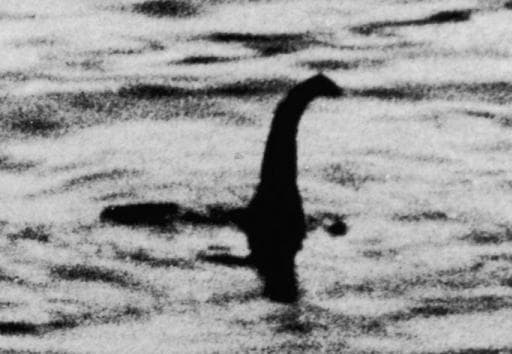 'The Surgeon's Photo'
'The Surgeon's Photo'
Public Domain Image
Many years later this was proven to have been faked, using
a toy submarine, photograph cropping and other trickery.
One of the people involved in putting together the 'Surgeon's Photo' scam was a big game hunter named Marmaduke Wetherell (who was connected to Dr Wilson through a mutual friend.
Wetherell himself had been mixed up in an earlier hoax in 1933, but whether as a creator, or a victim no one seems to know for sure. He had been commissioned by the Daily Mail newspaper to locate the creature in Loch Ness. It seemed that he had been successful when he found the footprints of 'a very powerful soft-footed animal about 20 feet long.'
When examined by the British Natural History Museum in London, zoologists identified the footprints as being those of a hippopotamus, not Nessie.
Now... just incase you were wondering what a hippopotamus was doing wandering around Loch Ness, the zoologists believed the prints were made using an object which had a hippopotamus leg or foot as a base. Something like an umbrella stand perhaps.
This sounds awful now, but at that time it wasn't unusual for people who had traveled abroad to have souvenirs which were made up using parts of exotic animals. As a big game hunter we can guess that Wetherell had access to such things, but it's possible he wouldn't have been the only one.
Did you know that there's a live Loch Ness webcam feed?
Obviously you can't see the entire loch, and the creature you're most likely to catch on it one of the local sheep, but it's cool to check out... and who knows, maybe you'll get lucky and spot Nessie. Find it HERE
Loch Ness Monster FAQ
There's a LOT of information out there on Scotland's Loch Ness Monster, and sightings. So much so, that it's a bit overwhelming when trying to summarize in any way. However, in addition to just reading the fascinating accounts give by eye-witnesses, there are a few things people want to know. Here are the answers to a few of them (as far as it's possible to give information on something that is still officially 'undocumented' that is!).
What does the Loch Ness Monster look like?
Over almost 1500 years there have been thousands of sightings of a strange creature in Loch Ness. Not everyone has seen the same thing, so there may be one Nessie, a family of them, or two (or more) different creatures.
However, here are the most common features described by eyewitnesses:
- Humped back (exact number of humps seen varies)
- Long neck
- Small head
How big is the Loch Ness Monster?
Overall Nessie is always described as being large, big, or enormous. References by eyewitnesses have indicated she may be as long as 70ft.
- Most popular length of Nessie by eyewitness estimation is 20 ft
- Maximum suggested length has been around 70 feet
What color is the Loch Ness Monster
The general consensus of opinion from all eyewitness accounts is that Nessie the Loch Ness Monster is anything from dark grey to black.
When was the Loch Ness Monster first seen?
The first documented sighting of the Loch Ness Monster was in 565AD although evidence exists that she may have been seen by local inhabitants prior to that.
Is the Loch Ness Moster real?
This is the million dollar question!
In spite of literally thousands of eyewitness sightings plus numerous photographs and videos, no firm scientific evidence of the existence of the Loch Ness Monster has ever been found.
Several investigative expeditions from the 1930's right up until 2018 have failed to find definitive proof of Nessie.
But, ss the saying goes 'the absence of evidence is not the evidence of absence', so the official verdict is that jury is still out on this.
If you're interesting in hearing what I believe (after almost two weeks of being immersed in Loch Ness creature info. and sightings) scroll down to find my thoughts on the whole thing.
Using my musings, plus the information on this page and your own research, you can then come to your own conclusions as to whether there really is an unknown creature living in Loch Ness or not.
What explanations have been given for 'Nessie' sightings?
There have been many alternative explanations for what eyewitnesses might have seen instead of the creature they believe they saw.
These range from being mildly ridiculous, like circus elephants, to the more logical, such as unusually large eels. Other common suggestions are seals, otters, bird or even just optical illusions.
It's also sometimes suggested, albeit indirectly, that over-active imaginations fueled by folklore and previous sightings/recounts are to blame.
After Arthur Grant saw a creature cross the road right in front of his motorcycle one night, it was suggested that his eyes were playing tricks on him due to the darkness, his motorcycle headlight and the number of trees. Something he firmly denied.
If there is a real prehistoric-type Loch Ness monster, what could it be?
Okay, so now we're into the realms of imagination, speculation and guesswork. There is no scientific or evidential proof of what we're going to look at here, simply some possibilities that I came across during my research.
If an enormous, unidentified prehistoric type creature (or creatures) lives in Loch Ness, and other Scottish lochs and rivers, there are a couple of options.
The first, and most popular, theory is that Nessie is a plesiosaur, or a descendent of this truly ancient creature. The word 'Plesiosaur' comes from the Greek 'plesios' meaning 'near to' and 'suaros' meaning 'lizard'.
Plesiosaurs were fish-eating, marine reptiles with long, slender necks, small triangular shaped heads and four four flippers. They lived in the time of the dinosaurs, in the Mesozoic era, around 200 million years ago.
There were many different types of plesiosaur and they could grow to be anywhere between five and fifty-five feet in length, basically they were real-life sea monsters.
Although these marine reptiles were once thought to be cold blooded and to lay eggs, but relatively recent research has shown that Plesiosaurs were most likely warm blooded, and gave birth to live young.
Eyewitness accounts of the appearance of Nessie, both in the water and out of it, are very similar to the appearance of a plesiosaur.
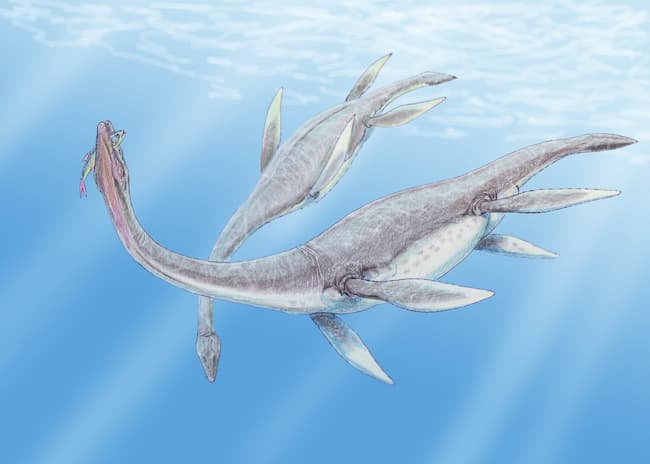 By Creator:Dmitry Bogdanov - dmitrchel@mail.ru, CC BY 3.0, https://commons.wikimedia.org/w/index.php?curid=3919828
By Creator:Dmitry Bogdanov - dmitrchel@mail.ru, CC BY 3.0, https://commons.wikimedia.org/w/index.php?curid=3919828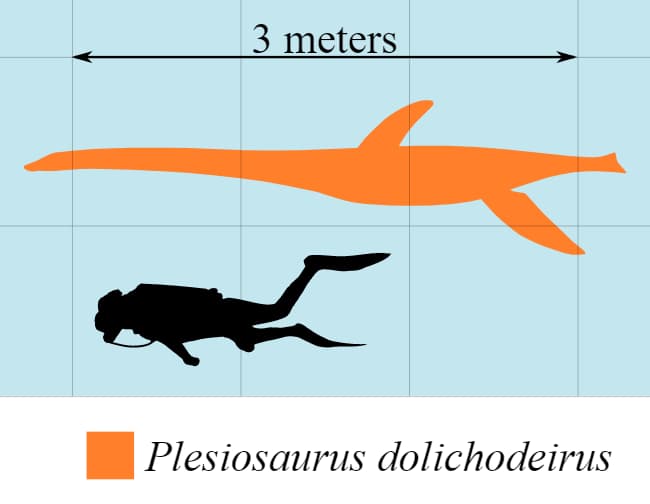 Plesiosaurus size compared to human. Public Domain image
Plesiosaurus size compared to human. Public Domain imageThere were over 150 different plesiosaur genera (different types of plesiosaurs) which existed all over the world during prehistoric times.
Many of them fit the general eyewitness descriptions of Nessie, as well as creatures seen in other Scottish lochs.
These include the Pliosaurus (which resembles the crocodile type creature eyewitnesses have seen in Loch Lomond), the Pachycostasuarus (known to live in the UK0, the Ophthalmothule (known to have lived in the Norwegian archipelago of Svalbard just over 2000 miles from Scotland's Orkney Islands), the Hauffiosaurus (known to have lived in the UK), the Cryptoclidus (known to have lived in the UK as well as other parts of Europe) and the Attenborosaurus (known to have lived in the UK and named after the biologist and natural historian, Sir David Attenborough.
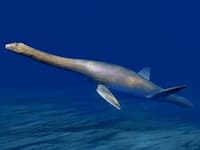 Cryptoclidus Reconstruction
Cryptoclidus Reconstruction
By Nobu Tamura. Own work, CC BY-SA 4.0, https://commons.wikimedia.org/w/index.php?curid=50279614
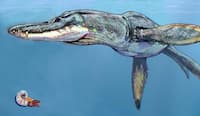 Pliosaurus rossicus
Pliosaurus rossicus
By Bogdanov dmitrchel@mail.ru - https://commons.wikimedia.org/wiki/File:Leedsi%26Liopl_DB.jpg">, CC BY 2.5, https://commons.wikimedia.org/w/index.php?curid=29025197">
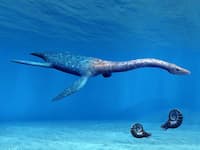 Attenborosaurus
Attenborosaurus
By Nobu Tamura (http://spinops.blogspot.ca/) - http://spinops.blogspot.ca/2017/06/attenborosaurus-conybeari.html, CC BY-SA 4.0, https://commons.wikimedia.org/w/index.php?curid=64007986">
There was also a variety of plesiosaur called an Elasmosaurus, which is known to have lived in the oceans surrounding North America over 80 million years ago which is also a good fit with the Nessie descriptions
I'm no scientist, geography buff or historian and this is just speculation, but given how much the physical geography of the world has changed since that time, could the Elasmosaurus be the mythical sea monster or sea serpent that sailors around the world have feared over the centuries, and that even today people claim to have seen?
Could the it then, also have existed as far east as Scotland? Is there another type of Plesiosaur that is Nessie's ancestor. We will quite possibly never know, but it's fun to consider the options.
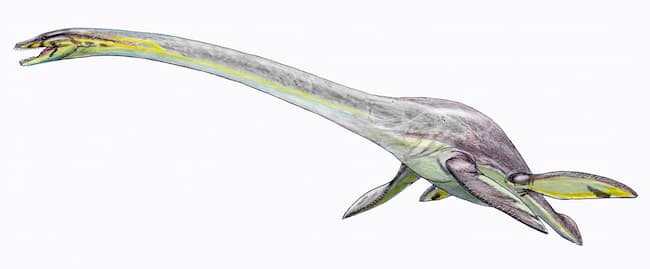 Elasmosaurus Restoration
Elasmosaurus Restoration
By DiBgd - Own work, CC BY-SA 4.0, https://commons.wikimedia.org/w/index.php?curid=42521876
 Elasmosaurus size compared to human.
Public domain image
Elasmosaurus size compared to human.
Public domain imageWhile a Plesiosaur of some type is the most popular theory, there are eye witness sightings of a creature in the water that doesn't fit this description so well.
Not to mention the ancient Pictish carvings of that mysterious creature which no one has been able to identify.
That brings us to the Ichthyosaur.
Like the Plesiosaur, the Ichthyosaur is ancient marine reptile, as is the Plesiosaur, and depending on the individual type of Ichthyosaur this lizard-fish could be anywhere between three and sixty-six feet long. Some fossilized remains found in Nevada indicate an Ichthyosaur that was the size of a sperm whale, and in 2021 an almost complete Ichthyosaur fossil of approx. thirty two feet in length was found in the central UK.
It's a confusing creature, with similarities to fish, dolphins, whales and crocodiles and may have had descendants who were aquatic but evolved to live on land, and then returned to the water. With a long, slender snout, a dorsal fin, humped back and fleshy flippers.
If you compare this 1863 illustration of an Ichthyosaur to the Pictish carving I don't think it's a stretch that they could be one and the same creature.
 1863 Illustration of an Ichthyosaur
1863 Illustration of an Ichthyosaur By Struthious Bandersnatch - Own work, CC BY-SA 1.0, https://commons.wikimedia.org/w/index.php?curid=9129402
By Struthious Bandersnatch - Own work, CC BY-SA 1.0, https://commons.wikimedia.org/w/index.php?curid=9129402In 1966, the fossilized skeleton of an Ichthyosaurus was discovered on a beach on the Isle of Skye (which is just off the northwest coast of Scotland).
It was in the National Museum of Scotland's storage facility from it's discovery until 2016 when a team of paleontologists began to study and analyze it. Eventually the plan is to display this amazing fossil so that everyone can enjoy, and marvel at, it.
This Ichthyosaurus is about thirteen feet long and, according to the University of Edinburgh it's a very rare specimen and the most complete skeleton of a marine reptile from the time of the dinosaurs that has ever been found in Scotland.
Check out the Storr Lochs Monster HERE.
My thoughts on the Loch Ness monster's existence
'While much is too strange to be believed, nothing is too strange to have happened' ~ Thomas Hardy
Researching the loch monsters pages for this site was an immersive experience (pun not intended). It was enthralling, fascinating, confusing and my brain hurt by the end of it all!
I'm sure everyone who is interested in this topic will have their own beliefs and interpretations of the information available. And even people who have spent their lives trying to find the answer to whether or not Nessie exists still don't have any definitive answers.
So no one is right, or wrong. Who knows when, or if, we'll ever know anything for sure, in terms of scientific evidence anyway.
But as I was looking at the reports of creatures in several Scottish lochs, it soon became clear to me that it would be possible for a creature to swim between lochs using the network of rivers, and that as these creatures had been seen on out of the water (even if not often) they were likely capable of crossing short stretches of land. It was equally possible for them to reach the open ocean.
The eyewitness descriptions were both similar enough, and varied enough, to suggest at least two creatures.
Could multiple generations of a prehistoric creature survive in the cold, deep, dark waters of Scotland's lochs, rivers and oceans? To my mind as long as there was food to sustain them, which there would be, it's potentially possible.
Finally, the enormous volume of well documented and detailed sightings over almost 1500 years (if you start with the time of St. Columba), makes me believe that there is something strange and unidentified, maybe several somethings, in Scotland's lochs.
Some of the sightings, videos, photos etc. were proven to be hoaxes, and some of the others likely had reasonable explanations that didn't include Nessie, but I believe a huge number of them are genuine and people (who usually weren't even looking for her) really did see the Loch Ness 'Monster'.
What do YOU think?
Citations & References used for info. on this page
- Christianity.com St. Columba Encountered Loch Ness Monster
- www.biography.yourdictionary.com/saint-columba
- www.lochnesssightings.com
- www.nessie.co.uk
- www.pbs.org/wgbh/nova/lochness/
- www.nationalgeographic.org/video/plesiosaurs-101/
- wikipedia.org Plesiosaurs
- wikepedia.org Ichthyosaurs
- Scholarworks.uni.edu Loch Ness Monster and her impact on culture
- Britannica.com
- zmescience.com
- The University of Edinburgh - Storr Lochs Monster
- Home
- Loch Ness Monster